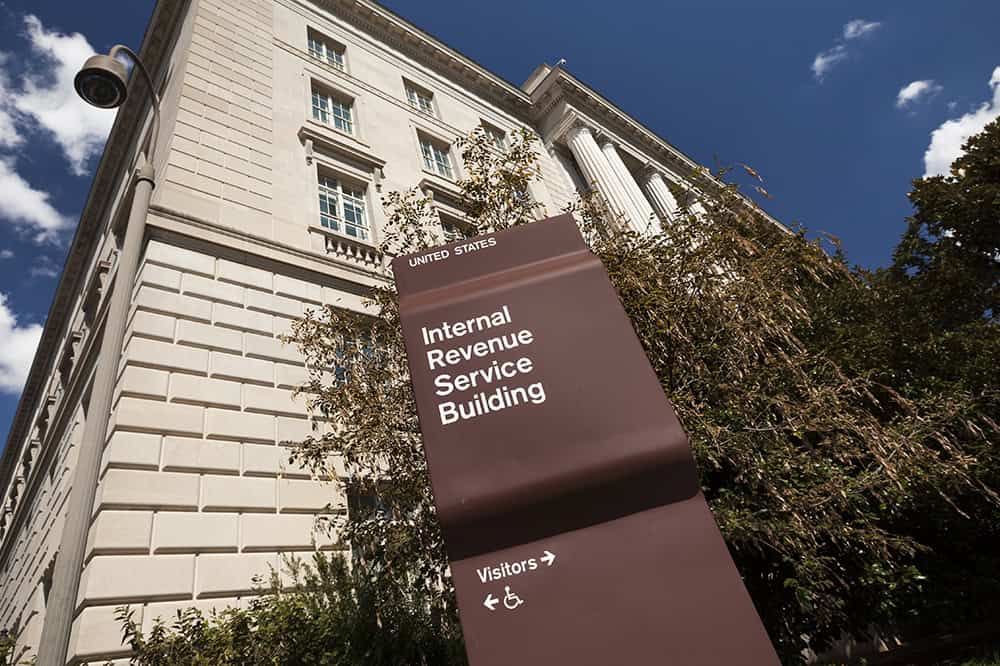The Next Fiscal Cliff: Big Tax Decisions to Make in 2025
Last Updated December 20, 2024
In 2017, the Tax Cuts and Jobs Act (TCJA) made significant changes to the tax code for individuals and corporations. While most of the changes to the corporate tax code were legislated to be permanent, most of the individual income tax provisions, as well as certain other provisions, are slated to expire at the end of December 2025. The choice to make some provisions temporary was made to limit the negative fiscal impact of the 2017 bill, but it sets up a significant decision point for policymakers next year — a “fiscal cliff,” with major implications for the country’s debt outlook.
Trillions of dollars are at stake. When the TCJA was enacted, the Congressional Budget Office (CBO) and the Joint Committee on Taxation (JCT) estimated that it would increase federal deficits by $1.4 trillion over a 10-year period, almost exclusively by reducing revenues.
Extending all provisions from the TCJA that are set to expire at the end of or phase out during 2025 would increase deficits by $4.0 trillion from 2025 to 2034, according to CBO. The largest categories of expirations — mostly from provisions related to individual income taxes — are included below, along with their effect on the deficit.
Extending the TCJA’s Individual Income Tax Provisions
Without action by lawmakers, changes to marginal tax rates and brackets, itemized deductions, tax exemptions, credits, and other portions of the federal tax system will expire at the end of December 2025. If extended, those individual income tax provisions would increase federal deficits by $2.5 trillion through 2034, according to CBO. Below is a brief summary of significant provisions and their estimated budgetary effects.
The estimates below reflect the effect of the largest provisions expiring at the end of December 2025; the individual estimates may not include potential interaction effects of permanently extending the provisions together.
Changes to Tax Brackets and Rates (−$2.2 trillion)
The TCJA lowered most individual income tax rates and altered most income tax thresholds. While maintaining the 7-bracket structure, the combination of lowering most of the tax rates and raising some of the thresholds, particularly for joint filers, significantly reduced the amount of revenues collected. Extending those provisions would keep rates and brackets at their current levels, thereby reducing revenues by $2.2 trillion through 2034 relative to reverting to previous law.
Alternative Minimum Tax (−$1.4 trillion)
The alternative minimum tax (AMT), which applies to individual income taxes, set limits on certain tax benefits to address concerns that high-income persons were avoiding paying income tax. The TCJA raised the AMT exemption amount, meaning the amount of income a taxpayer could earn before being subject to the AMT, and increased the phase-out income threshold (the gradual tax benefit reduction as the taxpayer’s income approaches the upper limit). In 2017, before the TCJA was enacted, about 3 percent of households paid the AMT. By 2019, just 0.1 percent of households paid it. Extending the TCJA AMT exemption level would keep the number of households subject to the AMT, most of which are high-income, comparatively low, and reduce revenues by $1.4 trillion through 2034.
Expansion of the Child Tax Credit (−$748 billion)
The TCJA expanded the child tax credit (CTC), which applies to qualifying dependents under the age of 17, doubling the maximum credit from $1,000 to $2,000 per child. It also increased the phase-out threshold from $75,000 for single and $110,000 for joint filers to $200,000 and $400,000, respectively. Extending the provision would reduce revenues by an estimated $748 billion over the following several years.
Changes to Standard and Itemized Deductions (Nearly Offsetting)
The TCJA doubled the standard deduction and made several changes to itemized deductions, which reduced the number of taxpayers who incorporated such itemizations. Extending the changes made to both standard and itemized deductions would effectively offset, reducing revenues by less than $7 billion through 2034.
- Increasing the standard deduction: −$1.3 trillion. The TCJA nearly doubled the standard deduction, the specific dollar amount that a taxpayer can earn before being subject to the income tax. The larger standard deduction simplifies tax filing for those whose itemized deductions would be less than the new standard deduction. In 2021, 92 percent of all taxpayers took the standard deduction instead of itemizing. Extending this provision would reduce revenues by an estimated $1.3 trillion through 2034.
- Eliminating or changing itemized deductions: $1.2 trillion. Itemized deductions allow individuals to subtract certain expenses from their taxable income. The most significant change to itemized deductions was capping the state and local tax deduction (SALT) at $10,000. Before the TCJA, when SALT was uncapped, about 30 percent of taxpayers claimed the deduction, with high-income households more likely to benefit. After the TCJA, the number of taxpayers claiming the now-capped deduction fell by nearly two-thirds, although the benefits are still disproportionately accrued by households with incomes over $200,000. Other itemized deductions were also affected (see table below). Extending all itemized deduction changes would increase revenues by $1.2 trillion through
Suspension of the Personal Exemption ($1.7 trillion)
The TCJA eliminated personal exemptions (a dollar amount that can be deducted from an individual's total income for each dependent in the household). The TCJA increased the standard deduction and child tax credits to replace personal exemptions. Extending the suspension of the personal exemption in isolation would generate an estimated $1.7 trillion in revenues through 2034.
Pass-Through Deduction (−$684 billion)
The TCJA also created a new “pass-through” deduction for taxpayers with income earned from partnerships, sole proprietorships, and S corporations. Income from such sources is not subject to corporate income taxes, as opposed to C corporation income. Up to 20 percent of income from such sources can be deducted from fillers' individual income taxes, although the deduction varies depending on factors such as the type of business and total income of its owner. Extending this provision reduces revenues by an estimated $684 billion.
Changes to Bonus Depreciation (−$378 billion)
The TCJA made a change to the tax treatment of certain qualified properties. If a taxpayer manufactures, constructs, or produces property for trade, business, or production, it can qualify for its first year of depreciation to be written off at 100 percent. The provision began phasing out at 20 percent a year in 2023 and is set to fully expire after 2026. Extending the change, including allowing amounts to be retroactively deducted, would reduce revenues by $378 billion through 2034.
Delayed Onset Business Tax Provisions (−$172 billion)
The TCJA enacted three business tax provisions that affect income earned abroad with formulas set to be modified at the end of 2025: the base erosion and anti-abuse tax, foreign-derived intangible income, and global intangible low-taxed income. Delaying the scheduled change of those formulas would reduce federal revenues by $172 billion through 2034.
Doubled Estate and Gift Tax Exemptions (−$167 billion)
In addition to tax provisions affecting individual income taxes, another major change in the TCJA affected estate and gift taxation.
The TCJA initially doubled the exemption for estate taxes (applied to property transferred from deceased persons to heirs) and gift taxes (applied to transfers between non-married individuals while alive) from $11.2 to $22.4 million for those filing jointly and $5.6 to $11.2 for single filers; those amounts were subsequently indexed for inflation. The TCJA retained a maximum rate of 40 percent on estates and gifts. Extending this provision would reduce revenues by an estimated $167 billion over the following decade.
How Would Extending Certain TCJA Provisions Impact Deficits and the Debt?
At the end of fiscal year 2024, debt held by the public represented nearly 100 percent of GDP. CBO currently projects that such debt, while assuming that provisions of the TCJA will expire as scheduled, will exceed its post-World War II high of 106 percent in 2028 and reach 122 percent in 2034. Extending the TCJA provisions in full would add an additional 11 percentage points to the debt, CBO reports, bringing it to 133 percent of GDP in 2034.
Conclusion
The TCJA included a wide range of provisions, many of which could be defensible or worthy of consideration as part of an overall tax regime. However, taken as a whole, it is undeniable that the TCJA made the country’s fiscal outlook worse. Moreover, when it was passed, lawmakers made many provisions temporary to make TCJA’s fiscal impact appear less damaging. Next year, lawmakers will be forced to confront that decision, and extending the full set of provisions would make the debt trajectory even more daunting. As 2025 approaches, policymakers must consider the benefits of the components of the TCJA against the impact of possible extensions on the growing debt. The good news is there are many options available for lawmakers to make fiscally responsible changes to the tax code.
Image credit: Photo by Chip Somodevilla/Getty Images
Further Reading
What is a Wealth Tax, and Should the United States Have One?
Proponents of the wealth tax argue that it could help address rising wealth and income inequality while also generating revenues.
What Are Refundable Tax Credits?
The cost of refundable tax credits has grown over the past several years, with the number and budgetary impact of the credits increasing.
Eight of the Largest Tax Breaks Explained
Tax breaks totaled over $1.9 trillion in 2024. That’s more than the government spends on Social Security, defense, or Medicare and Medicaid.


